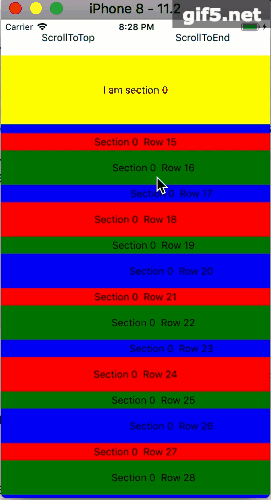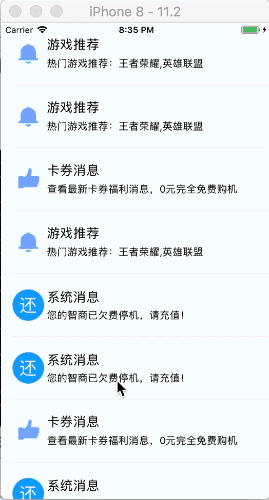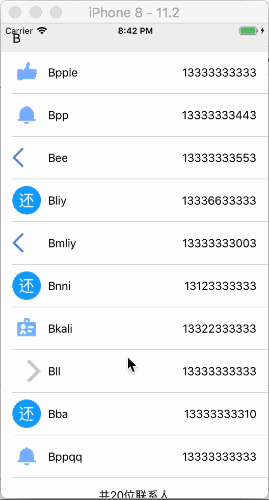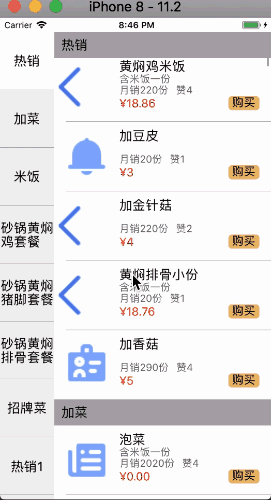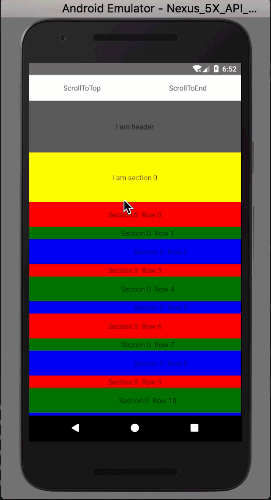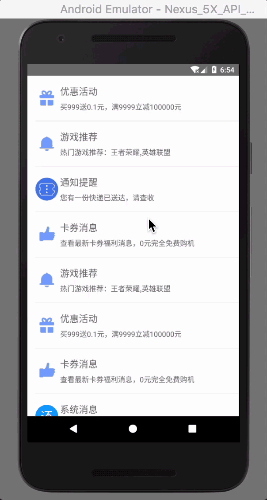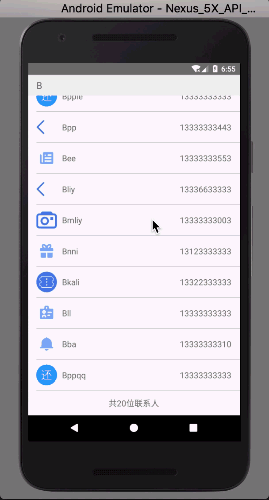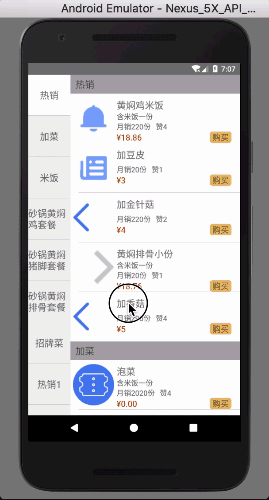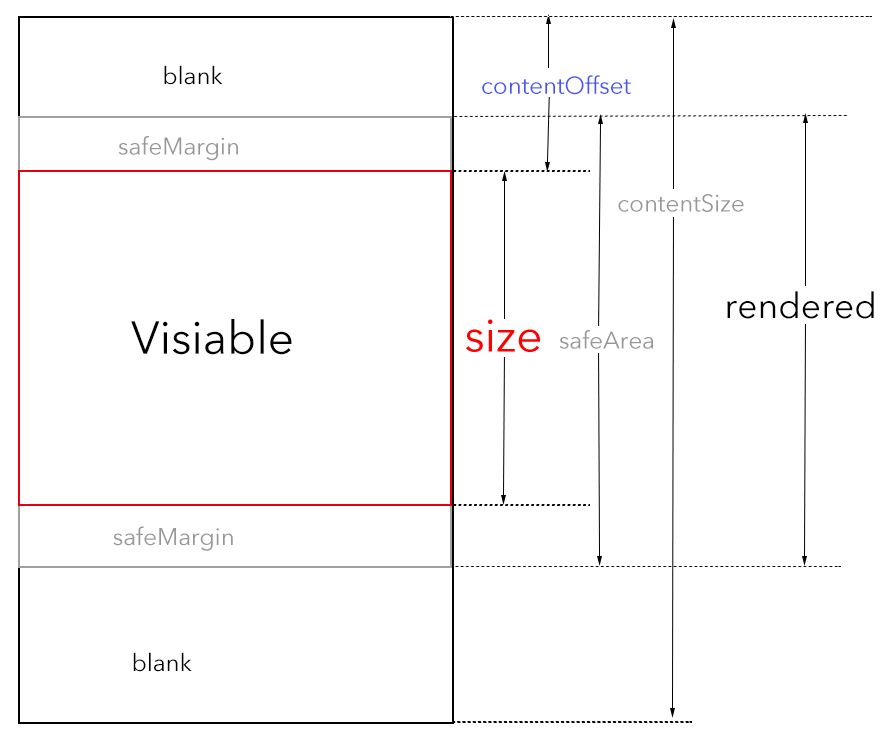中文文档请 点击这里
React-native-largelist is a high performance large list component for React-Native. It's performance is much better than SectionList.(iOS & Android).
- The performance of react-native-largelist is much better than FlatList and SectionList.
- Large data source supported, infinite data supported, super fast sliding support.
- Full cross-platform.
- Section support.
- Callback when Cell/Item enter/leave the safeArea support.
- List header/footer support.
- Pull to Refresh and Scroll loading more.
- Scroll loading more custom view support, all data source load completed custom view support.
- Dynamic variable support, for example: size, contentOffset, currentSection, contentSize, height of Header/Footer, visibleIndexPaths and so on.
- Scroll to offset or index path.
- Reload data.
- Custom optimize parameters.
- More callbacks or dynamic variable can be added through a new issue.
View the video of react-native-largelist performance on youtube or youku
- Make sure your project is react-native project.
- Using this command to install:
npm install react-native-largelist --save
- Using it like this:
import { LargeList } from "react-native-largelist";
//other code
...
<LargeList
style={{ flex: 1 }}
bounces={true}
refreshing={this.state.refreshing}
onRefresh={() => {
this.setState({ refreshing: true });
setTimeout(() => this.setState({ refreshing: false }), 2000);
}}
safeMargin={600}
numberOfRowsInSection={section => this.props.numberOfEachSection}
numberOfSections={()=>this.props.numberOfSections}
heightForCell={(section, row) => row % 2 ? this.minCellHeight : this.maxCellHeight}
renderCell={this.renderItem.bind(this)}
heightForSection={section =>section % 2 ? this.minSectionHeight : this.maxSectionHeight}
renderHeader={this.renderHeader.bind(this)}
renderFooter={this.renderFooter.bind(this)}
renderSection={section => {
return (
<View
style={{
flex: 1,
backgroundColor: section % 2 ? "grey" : "yellow",
justifyContent: "center",
alignItems: "center"
}}
>
<Text>
I am section {section}
</Text>
</View>
);
}}
/>
...
import { LargeList } from "react-native-largelist"
Props:
| Props | type | default | effect |
|---|---|---|---|
| (ViewPropTypes) | (ViewPropTypes) | All props of View | |
| numberOfSections | ()=>number | ()=>1 | number of sections in tableview |
| numberOfRowsInSection | (section:number) => number | section=>0 | function:return the number of rows in section |
| renderCell | (section:number,row:number) => React.Element | required | function: render of cell with section and row index |
| heightForCell | (section:number,row:number) => number | required | function:return height for cell with section and row index |
| renderSection | (section:number) => React.Element | section=>null | function:render of section with section index |
| heightForSection | (section:number) => number | ()=>0 | function:return height of section with section index |
| renderHeader | () => React.Element | ()=>null | function:render of header in the tableview |
| renderFooter | () => React.Element | ()=>null | function:render of footer in tableview |
| bounces | boolean | true | bounces |
| refreshing | boolean | undefined | refreshing |
| onRefresh | () => any | undefined | callback of pulling to refresh,if not undefined ,a default RefreshControl is add to LargeList |
| onScroll | ({nativeEvent:{contentOffset:{x:number,y:number}}})=> any | Callback when scrolling. |
Before we learn advanced usage, we must first understand the basic principles:
Every Cell/Item is reused just like UITableView/RecyclerView. The top Cell/Item which is Slided to the outside of the visible region does not need to show. So, I move it bottom, render it with the new datasource.
But,as you know, It is different with native UITableView/RecyclerView. They are not one thread between Main Thread(UI Thread) and JavaScript Thread. And They are asynchronous, and the communication between them may take not a few time. So, I try to render more Cells/Items at the upper and lower ends of the visual area. I call it safeArea. And I use it to buffer, to avoid the user slide suddenly and the visual view of the upper and lower edges is flickering.
Look up the design of react-native-largelist:
- type: number
- default: 600
- The height of rendering children out side of visible area. The greater the value is, the less easily you see the blank in the fast sliding process, but the longer the first time it is loaded
- type: number
- default: 500
- The height of dynamic safe margin when sliding too fast. For example, if safeMargin=600 and dynamicMargin=500, it will render 100 height on top and 1100 height on bottom out side of the visible area when sliding down too fast.
Notice:
- It does not work when the speed of sliding is slow.
- It can not be set larger than safeMargin
- type: number
- default: ios:16
- It is the same as scrollEventThrottle on ScrollView
- type: (indexPath:IndexPath)=>any
- default: ()=>null
- The callback when an indexpath did enter safeArea.
- type: (indexPath:IndexPath)=>any
- default: ()=>null
- The callback when an indexpath did leave safeArea.
- type: bool
- default: true
- Show vertical scroll indicator.
- type: section=>any
- default: ()=>null
- The callback when a new Section hang on the top of the LargeList.
- type: number
- default: 4
- If the speed of scrolling is faster than speedLevel1, LargeList will not rerender, just use "setNativeProps" to move the position. Unit is logic pixels/ms.
- type: number
- default: 10
- It does not work for the current version.
- type: bool
- default: false
- Use native optimize, iOS only. This is an experimental prop.If it is set, safeArea doesn't make sense. To use the prop, you should add "${YourProject}/node_modules/react-native-largelist/ios/STTVTableView.xcodeproj" to your iOS project. And make sure link it.
- type: ()=>any
- default: null
- The callback when pull up on the bottom
- type: ()=>number
- default: ()=>70
- function: return the height of Loading More View.
- type: bool
- default: false
- Did all data source load completed?
- type: ()=>React.Element
- default: ()=> < ActivityIndicator style={{ marginTop: 10, alignSelf: "center" }} size={"large"}/ >
- The render of custom Loading More View
- type: ()=>React.Element
- default: ()=> < Text style={{ marginTop: 20, alignSelf: "center", fontSize: 16 }}>No more data< /Text >
- The render of custom Loading Completed View.
Scroll to offset.
Scroll to an indexpath.
Scroll to the end of the LargeList.
Get the visible indexpaths at this time.
Get the rendered indexpaths at this time.
Get the count of free views at this time.
Reload datasource on indexpath partially.
Reload datasource in some indexpaths partially.
Reload all datasource partially.
Notice:
- reloadIndexPath, reloadIndexPaths, reloadAll work partially. They do not work well when the numberOfSections ,numberOfRowsInSection,heightForSection,heightForCell change.Use reloadData instead.
Reload all datasource globally.
Notice:
- If the numberOfSections ,numberOfRowsInSection,heightForSection,heightForCell change, you must use this method to reload.
- Do not use this method often, because it is bad performance.
Current size of LargeList. Size:{width:number,height:number}
Current contentOffset of LargeList. Offset:{x:number,y:number}
Current safeArea of LargeList.. Range:{top:number,bottom:number}
Current topIndexPath of LargeList. IndexPath:{section:number,row:number}
Current bottomIndexPath of LargeList. IndexPath:{section:number,row:number}
Current contentSize of LargeList. Size:{width:number, height:number}
Current section index of LargeList.
Get LargeList's header height
Get LargeList's footer height
- Fix bug
- Left and right swipe out to edit cell.
- Code optimization, support typescript.
- Add loading more
- Fix bug when reload data
- Fix bug on "scrollTo" when animated == false
- Change "visiableIndexPaths" to "visibleIndexPaths", "visiableIndexPaths" will not support after 2.0.0
- Change the type of "numberOfSections" from number to function, number will not support after 2.0.0
- release
